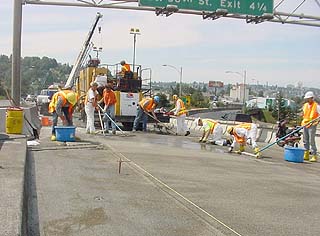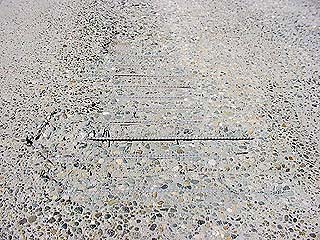|
Subscribe / Renew |
|
|
Contact Us |
|
| ► Subscribe to our Free Weekly Newsletter | |
| home | Welcome, sign in or click here to subscribe. | login |
Construction
| |
 |
June 18, 2004
Polyester concrete — a quick fix for roadways
WSDOT

Photos by Jim Findley/WSDOT
Once polyester concrete is placed, it can be driven on in about an hour.
|
After 40 years of service, the southbound Interstate 5 Puyallup River Bridge near Tacoma was in need of major repairs. Heavy use had worn the concrete deck to the point where reinforcing steel was exposed in several spots.
It was time for the state Department of Transportation to assure that it would continue operation with little or no delay.
Tasked with the duty of designing and administrating a contract to make the improvements, WSDOT staff evaluated the options. Typical repairs in this situation call for preparing the surface and placing a 1½- to 2-inch layer of concrete on the top of the bridge deck. Unfortunately, conventional concrete products require moisture curing to develop both strength and durability.
Curing can take several days, and up to a week in some cases. During the curing process, the bridge deck is out of service 24 hours a day. In the best-case scenario, with just one lane of I-5 constructed at a time, experts estimated traffic backups would range from 10 to 16 miles during peak travel periods and last up to six hours a day. This magnitude of impact was unacceptable.
The alternative in conventional technology was to overlay the bridge deck with hot mix asphalt. The application of hot mix, along with a protective membrane, could achieve nearly the same level of protection of the bridge deck at a lower cost.
The drawback is hot mix doesn't last as long, in most instances less than a third as long as conventional concrete. Hot mix also is not structurally adequate for the 17 expansion joints along the bridge. In those locations, the asphalt would have to be removed and replaced with a concrete “joint.”
Given the deficiencies and lifecycle costs of hot mix, polyester concrete was considered.
Polyester concrete is produced and placed much like conventional concrete. It contains aggregate and sand blends. In lieu of cement and water, a catalyzed polyester resin is used to bind the mineral aggregates. The cure time of the polyester mix is adjusted by the type and amount of catalyst used. In many cases, the mix can be fully cured and ready to drive on in less than an hour.

The deck on the Puyallup River bridge on I-5 was so worn that rebar was exposed. Polyester concrete was used as a replacement deck.
|
Polyester is not a cure all. It is highly susceptible to failure if moisture is present prior to curing, it is limited to a narrow work window in Western Washington, and it is expensive on a cubic yard basis compared to asphalt or conventional concrete.
In short, polyester concrete has many risks that need managing during the design and construction phase.
On the Puyallup River Bridge, traffic volumes were so high, we had a tough decision. Do we go with the conventional concrete treatments and back up traffic or do we go with hot mix asphalt and replace it every five to seven years?
We could not allow commuters to sit in near grid-lock conditions for two months, nor could we afford to place workers at risk.
Design considerations involved a balance of traffic impacts, worker safety, product quality and cost. The final decision was to use polyester concrete along with a quick-change movable barrier system. That allowed the contractor to work around the clock while providing plenty of time to plan the work for the driest time of the year.
The project was awarded in March 2003 and the first working day was predetermined in the contract to be July 8. Restricting traffic outside the evening shift was limited to four 55-hour weekends.
| A bad start |
|
Polyester concrete is not new to our state. It was used in 1990 on a bridge deck in Bremerton. That first project didn’t cure properly and was labeled a failure. After that experience, WSDOT engineers shied away from the material. Years later, the technology changed and WSDOT felt it could manage the risk. The first chance to use the new technology was in 2002 for an overlay of Interstate 5’s northbound lanes in the Ravenna area of Seattle. That project came off successfully, leading to its use for the Puyallup River Bridge project in Tacoma. WSDOT is now eyeing about 20 other projects that could use the material. |
Incentives for reducing traffic impacts were added to the bidding documents. Called “A+B” bidding, the contractor was able to bid how many days it would take it to do the work in addition to the weekend closures. The successful bidder, Concrete Barrier Inc., proposed completing all the work in less than 18 additional days. If the contractor completed the work in less than 18 days, it would be entitled to additional compensation.
During the first two weekend closures, Concrete Barrier refined its production methods and increased productivity. The contractor then proposed to finish the project with only three weekend closures, if it got an additional incentive.
The proposal was evaluated and it was agreed that the cost savings to the traveling public far exceeded the cost of the incentive, and the agreement was executed.
Concrete Barrier went to work making modifications to its equipment, brought in extra help, and went to work late Friday night of the third weekend, knowing it was not going to stop until the project was completed.
By Sunday evening when the last of the material was placed, we were all breathing a lot easier.
Fred Tharp, P.E., was the WSDOT project engineer for both design and construction management on this project.
Other Stories:
- Concrete, technology are a powerful mix
- Shedding a new light on the heavy stuff
- Concrete struts its stuff in Washington, D.C.


